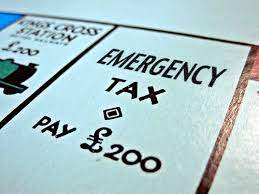
Emergency tax is the temporary imposition of a higher tax rate on all your earnings, which results in a smaller salary than normal. The good news is that it can be avoided, and if you need to pay emergency taxes, you can be reimbursed.
Emergency tax usually occurs when HMRC does not have accurate or adequate information about you, your income, or your tax status. Due to a lack of information, they will be unable to supply you with the right tax code – which means you will be issued with an emergency tax code.
An emergency tax refund is a refund of taxes that you might owe. The amount of tax refund you get depends on the type of tax return.
What is an Emergency Tax Period?
An emergency tax period is a short period where you can pay your taxes without penalty. It is a legal tax-free period that can last from one to six months.
An emergency tax period is a temporary tax that can be imposed on the income of individuals and companies when there is an emergency. An emergency tax period aims to generate revenue to cover unexpected expenses or when there is a sudden loss of income.
An emergency tax period is when you have to pay some taxes. It can be on a monthly, quarterly, or yearly basis. An emergency tax period may last for one month, two months, or even three months. You need to pay tax on the amount you owe, and you also need to declare it when filling up your tax return.
You can either pay the amount due when filing your tax return or file an amended return after paying the taxes.
If you do not pay any taxes during this period, there will be no penalty or interest charges on your income tax returns. However, if you do not declare these taxes before the end of this period, there will be a penalty charge and interest charges on your income.
How To Get Rid Of Emergency Taxes
A tax refund is a rebate that a person may receive from the government. If you have been refused a refund or not received one, it is essential to understand what happens when applying for a tax refund.
However, it might not be easy because of the complexity of the process and the time it takes. The tax refund is a little-known but essential part of the budget that we all need to get. It is a simple calculation that can be done quickly with a few clicks on the internet.
How to deal with emergency taxes
Be sure to provide your new employer with the details of your previous income or pension if you are put on an emergency tax code. If you do not have a P45 form, you can submit a new starter checklist.
We will automatically update your tax code. Your employer or pension provider will be informed about your updated PAYE Coding Notice, and HM Revenue and Customs (HMRC) will make the update to your code.
Be sure to check your next payslip to see if your new tax code is indicated, as well as any corresponding tax deductions. Contact HMRC as soon as possible if this is not the case. Despite the possibility of a bigger tax refund, cash available will be limited.
Conclusion
There are many reasons why you should start using an emergency tax refund today to save time and money. With a quick and easy process, you can get your refund in just a few days.
It’s easy to get confused and overwhelmed when filing taxes. When faced with financial emergencies, the last thing you want to do is file for a tax return. This can be a nightmare.






